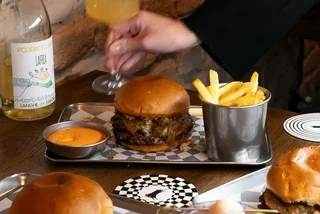Traditionally pancakes were eaten on the last Tuesday before Lent, as it was the final chance to enjoy a bit of indulgence before beginning into forty days of fasting and abstinence. Pancake recipes are pretty simple – usually just eggs, flour and milk – and so in our age of abundant food, it seems almost laughable that in a more puritan past, these basic ingredients were seen as luxuries, and therefore out of bounds for Lent.
Still, for many people, pancakes maintain the mystique associated with forbidden food. There’s also a sense of occasion in having an annually appointed day just for pancakes. But perhaps most of all, it’s the childhood thrill of tossing pancakes – seeing the golden disc rise from the pan, slowly turn in mid-air, and land (almost always) successfully back in the pan – that gives pancakes their magic.
In the UK, many children simply know the day as Pancake Tuesday, although its more formal moniker is Shrove Tuesday or Shrovetide. In fact, it was in Britain where sweet pancakes made from wheat flour were originally distributed to the poor on Shrovetide.
In French-speaking countries, the day is famously known as Mardi Gras. In the Czech Republic, it’s known as Masopustni útery, while our German neighbors know it as Fastnachtdienstag. No matter what you call it, it's all about enjoying a sinful indulgence or two.
To the Czech mind, the word “pancake” can be translated one of three ways: Lívance, or yeasted pancake, or palačinka, meaning, well, pancake. There's also bramborák, a potato pancake.
Lívance

Lívance are a type of Czech pancake similar to their airy American-style cousins. Lívance are small, fluffy pancakes, where the rise is created by yeast, rather than baking soda or baking powder. Traditionally, lívance are cooked in their own frying pan (you may recognize it, a strange shallow frying pan with four circle-shaped wells in it). These are a breakfast dish, often served with sour cream and hot fruit syrup, such raspberries or blueberries and dusted with icing sugar. Try making them with this simple recipe from the Very Good Cook food blog.
Palačinky

Palačinky most resemble crepes, the large thin circles that many of us think of when we hear the word “pancake”. There’s no raising agent required, and the batter is simple and quick to make. The Czech version is usually made from wheat flour, milk, and eggs and served filled with jam or quark cheese and topped with confectioner's sugar or whipped cream. Czech Cook Book has a recipe here.
Bramboráčky

These are potato pancakes that are shallow-fried in oil. They are made from grated potatoes, flavoured with garlic and bound together with egg and flour. The bramborák is a staple of Czech cuisine and is often served as an accompaniment to guláš. This is real Czech street food, often found at festivals and market stalls around the country. It’s hot, greasy, and satisfying. Radio Prague has an English-friendly recipe here.
Foolproof pancake recipe
This recipe makes about 6-8 pancakes, depending on the size of the pan. Toppings can be either sweet or savoury.
Trainee Recruitment Consultant - French Team!

- 125g flour (hladka)
- 225ml whole milk
- 1 egg plus 1 egg yolk
- Pinch of salt
- Knob of butter to fry
- 1.In a large bowl, whisk together the flour, egg and yolk, and half the milk until you have formed a thick paste. Add the salt and thin the paste using remaining milk. Whisk thoroughly. Pass the batter through a fine sieve, to catch any lumps and refrigerate for at least 30 minutes.
- 2.Heat a large non-stick frying pan on a medium-high heat. Take your time, you want the pan to be properly hot. Once the pan is warmed through, add a little butter. It should sizzle and spread around the pan.
- 3.Working quickly, add a small ladleful of batter to the pan. Lift the pan and tilt it, to ensure that the batter spreads evenly.
- 4.The colour and texture of the batter will change as it cooks. Once it looks dry, flip the pancake using a fish slice (or if you’re feeling brave: a double-handed lob).
- 5.Allow to cook for thirty seconds or so on the other side, and then slide on a warm plate.
- 6.Add another small amount of butter and repeat steps 3-6.
Sweet ideas: Sugar and lemon, Banana and Nutella, Jam, and whipped cream
Savoury ideas: Ham, Emmenthal and walnut, Bacon, Gruyere, and shallot












 Reading time: 3 minutes
Reading time: 3 minutes 




 English
English
 Danish
Danish
 German
German


















